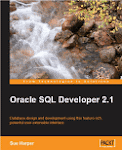I am sure by now you have read and absorbed LewisCunningham's fab article, previously mentioned, covering all SQL Developer reports, shipped and user defined.
In release 1.1 we bring you the same functionality and more. In 1.1, you'll be able to create master/detail reports anduse the new charting capabilities. Also, users will be able to query and kill sessions using this reporting functionality. This latter, a much requested feature. I hasten to add, this is all subject to change, but will give you an idea of what's coming down the line. For more information of planned features, please read the statement of direction on OTN.
The first screen shot illustrates a new report in SQL Developer; a chart displaying the object distribution for a user. You'll also have access to this charting capability, when creating user defined reports.
Of course you'll still have the option of switching users to run the report for another user, without too much difficulty. Below is the same report, but I've switched from HR in my Enterprise database to HR in my XE database, who's not a busy user!
The context menu on this section of reports has also changed. There are a few useful options, including offering you the ability to import or export reports. Notice too that you'll be able to create your own folders and add reports in this section, thus giving you the added benefit of keeping all your Data Dictionary reports together.
Now for a little change to a report you know...
Under the Sessions node, you currently have a Sessions report. In SQL Developer 1.1, this has been changed to a master/detail report, as illustrated in the image below. It would be tedious here to go through each of the tabs, but you can see for the active SYSTEM session selected, more detail is displayed below.
Users with the privileges to do so...
Let's briefly look at creating a user defined master/detail report.
I'll do a basic EMP and DEPT report for SCOTT. In the image below, note the ability to test your query. When testing, initially you select and run for a particular database connection. The test feature is all the more useful when you have a more complex report, with a few more clauses, driving the data selection.
I could have chosen to display this as a chart instead. Having selected Chart for the report style, I get more options for defining the chart. See the Chart Details tab to the bottom left.
Now to add the detail (child) report. Note the bind variable matches the column name in the master report.
Before you save the report, you can test it again. This time you'll be testing the full master/detail report and can verify that not only do your queries work, but that you do indeed have the correct binds. I won't show you that test, instead have just shown you the executed report below. Notice the same column ordering ability I mentioned in SneakPeak1.
More sneaks peaks next week.










6 comments:
Oh, that's lovely!
I had a customer that was very annoyed about the "missing" kill session option.
The enhanced reporting looks great. I guess the next thing that users will ask it to export the reports (table and graph) to their mail/word/excel...
The export/import report is great, it will allow the community to easily collaborate and share reports. BTW, could we import reports using the commandline (so we can do silent report installation/deployment)? Yeh, I know I'm a bit greedy (-;
Ofir,
You can expert the reports, I never mentioned that in my blog entry. The options are the same as for the data grid in the SQL Worksheet, which now also includes HTML format. Nothing for mail, but we hope to add plan pdf format.
Commandline request: Kris does a lot with the command line, but what you'll be able to do in 1.1 I'm not sure. More research for me.;-)
Sue,
Awesome! SQL Developer has come so far so fast. This is some great stuff!
Thanks,
LewisC
http://blogs.ittoolbox.com/oracle/guide
Thanks Sue. I also vote for a command line interface to export reports into a format like HTML or PDF. This was it becomes really powerful tool and not only personal reporing tool.
Ideally, it would be better to have a striped down componenents that can produce reports developed in SQL Developer. :)
Thanks for the feedback, all.
We'll be exposing a site called SQL Developer Studio soon. This will give you the space to add feature requests and add votes to other people's feedback and requests.
As for the commandline/cutdown version, we do indeed plan to have that kind of support, no release set for that. The HTML and PDF formats will be available for 1.1
Sue
Sue, u saved lotta my time.
Thank you :)
Post a Comment